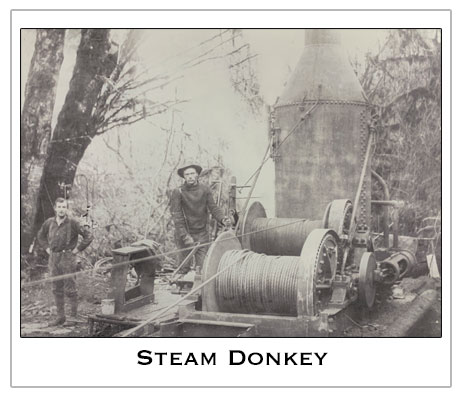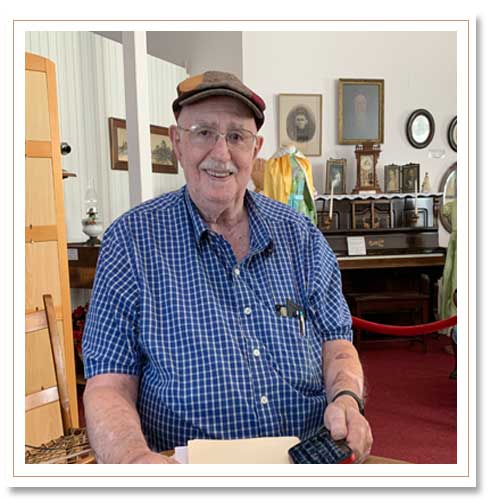In 1885, “They came from Indiana with 5 children by train to San Francisco,
then by schooner to Portland.
This story follows an interview with Delbert (“Del”) Phelps for the museum’s Oral History Project. The project strives to capture an understanding of days gone by and the experiences of the people who lived them.
Del Phelps has had an interest in history for as long as he can remember. He claims it likely is due to knowing how his grandparents came to Oregon, homesteaded, and raised their family there. His grandfather, Jonathan C. Phelps was a Civil War veteran, and came West in 1885 with his wife (Charlotte) and family. “They came from Indiana with 5 children by train to San Francisco, then by schooner to Portland.” They applied for a homestead in Indian Creek after consulting a map and determining the area was rich with timber, and had a creek running adjacent to the land. Together with his eldest son who was old enough to acquire land, the family obtained 240 acres. They lived in Yamhill for three years. In the early summer of 1888, they travelled by wagon train to Eugene City, (now known as Eugene). Their youngest son was Del’s father Jessee, who was 10 years old.
GETTING TO THE HOMESTEAD
The journey to Mapleton from Eugene City was by trail. Unable to maneuver the overhang of Beacher Rock by covered wagons, they continued by buckboard wagon to Rain Rock on the Siuslaw River. From there, the only route to Indian Creek Valley was to navigate up the Thompson Hill trail. All of their belongings (stove, pots & pans, etc.) were unloaded onto handcarts. They pushed the handcarts up the trail traversing 4 switchbacks, then down the other side and another 4 miles to their homestead. With no living quarters, their first task was to build a cabin. Once completed, their new life was begun with the cabin, a cow and a pig. Indoor plumbing and electricity had not yet come to the area.
THE MOVE TO INDIAN CREEK
In 1914 Del’s father, Jessee Phelps was 35 years old and married Isole Dorothy Ewbank, a teacher in Herman. He worked for Mt. June Lumber Company as a bull buck. The following year, Del’s sister was born. A son was born in 1917 and Del was born in 1935 in Eugene. In 1938 they moved to a farm a mile up of Lost Creek in Dexter. Tragically, Del’s mother died in 1943 following an illness. Del was 7 years old. That same year, Jessee’s cousin injured his arm in an accident, and asked him to move to Indian Creek to oversee his logging operation. Jessee obliged and moved to Indian Creek in 1944 with Del. By that time, Del’s siblings were older, on their own and living elsewhere, so it was just he and his father. With his father working in the sawmill during the day, Del remembers enjoying a great deal of freedom in his childhood – “as long as he was home in time for supper”. At 11 years old, he gained his first experience working at Phelp’s Sawmill (his cousin’s mill) “just for the fun of it”. His job was putting chokers around logs in the pond and hooking it to cables pulling the logs up into the mill. He recalls at one time there were 8 mills on Indian Creek, most of which made ties for the railroad and Jew Plank (3 x12) that were shipped by railroad to the mid-west. At 15 he worked with his father on plumbing jobs in the homes built for mill workers.
SIMPLE LIVING
Del contends Indian Creek was a good place to grow up. Despite no home insulation, refrigeration or indoor plumbing, they were resourceful. He explained that in the early days, items were kept cool by putting them in a wooden slatted box. The box was made with a wire bottom and lid, then placed in the creek. Spring water was pumped to the cabin. Instead of indoor plumbing, an outhouse sufficed. With the house in close proximity to the mill, their power source at one time came from the mill itself. They hunted, and during the fall salmon run, fish were plentiful. During the evenings, neighbors would come together on someone’s front porch to enjoy music and home brew. It wasn’t until 1953 that electricity became available, and plumbing soon followed. It was also in 1953 that Dell was among the 26 graduates from Mapleton High School. His favorite class had been physics, which came to serve him well later in life.
THE MONEY SAWYER
Among his first jobs after completing high school was as a whistle punk in the woods. He explained the job involved a communication system of sorts to relay signals by wire with the logging yard engineer (200 or 300 feet from the steam donkey). As a whistle punk, he was stationed with a view of the workers who hooked chokers onto the logs before they went to the mill. The hook tender man instructed the workers which logs to hook next. He (the hook tender) would tell the whistle punk what he wanted the donkey to

do. The whistle punk would then communicate to the steam donkey with a clicker device over the wire. The donkey would send a series of “toots” (sounding similar to a car horn) to signal instructions (go, stop, fast, slow, tighten line, bring logs in, etc.).

After his first summer in the woods, Del went to work in his cousin Orvil Phelps’ sawmill (which became Davidson Industries in 1954). The next summer Del married and moved from Indian Creek to Mapleton where he and his wife would live until 1959 when they moved to Florence. Del advanced to the highly skilled position of head sawyer in just 7 years at the mill. He was responsible for using precise measurements to cut boards in the most efficient and profitable manner for the mill. It was a position he held for
INNOVATION AT THE MILL
Davidson Industries welcomed computer technology in the mill. As the industry began looking for more efficient methods of performance and profit, Del strived to broaden his knowledge in all aspects of the mill. This included playing a key role in helping to innovate sawing procedures to the computerized system of today. He worked with computer programmers in the late 1970’s and early 1980’s, to develop new sawing methods which resulted in its successful transition. To further his understanding, he enrolled in a Cobol computer programming class at Lane Community College in 1979. In hindsight, he claims the class allowed him to keep abreast of the current innovations and those which were soon to come.
He helped establish a planerman organization to educate its members by exposing them to new developments in their trade. It also gave them the opportunity to exchange ideas and new techniques with others in the field. The organization grew to 500 members from all over the country. In the ensuing years, he organized 2-day conventions held in Eugene, featuring experts in the field of planing. In 1987 he was a featured presenter at the Forest Industries Magazine’s Sawmill Clinic in Portland.
COMMUNITY SERVICE
Shortly after moving to Florence in 1959, Del was asked to join the Volunteer Fire Dept. and the Jaycees. It was a defining moment for him, introducing him to a type of work he hadn’t previously done, and found it to be highly rewarding. According to him, being involved with the Jaycees encouraged him to pursue additional community service work as well. He began volunteering after his normal work day in various projects and organizations. He joined the school board in 1974 for 8 years, the City Council in 1976 for 8 years, County Budget Committees, Oregon Coastal Zone Management Commission, the Elks, and numerous others. He was also instrumental in fundraising efforts for the Peace Health Hospital.
In 1987 he formed a corporation, then an LLC. In the ensuing years, along with a group of investors, 67 acres were acquired. They began planning for the first phase of Florentine Estates. The building of Florentine occurred during the decline and closure of the sawmills. Many who had lost their sawmill jobs transitioned to construction and plumbing trades. They became much of the workforce for the Florentine construction project. In all, the successful Florentine Estates project took 15 years to build in 12 phases, and resides on 180 acres with 443 lots.
It became obvious to me during our interview, that Del Phelps maintains an intimate and personal connection to the area’s history. I asked about his early “vision” and pursuit of the many accomplishments and successes he has achieved. Without hesitation, he professed that “volunteer experience gives you a bigger perspective of how the world works”. He further revealed that for him, it’s been the rewards of community service that he is most proud of. He was named Florence First Citizen in 2008. We are fortunate that Del continues to honor the history of the area’s pioneers by choosing to preserve their lives and experiences through the Siuslaw Pioneer Museum.

